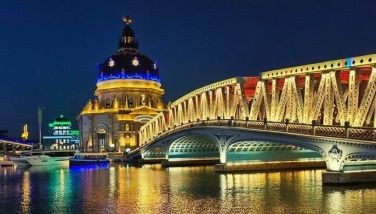Two grandfathers and a perished queen
MANILA, Philippines - My maternal grandfather was a fiery 1920s lawyer who abhorred seeing his wife in the teaching profession because he thought every teacher was a slave; so he told her to stop teaching, stay home and have a good life. He didn’t live long enough to see his only child walk, grow up a young woman, embrace the same profession he disliked, and become a teacher well-loved by barefoot graders in some public school where parents sent children to class for no particular reason except to send them to class and end up more confused about life.
I have seen my old man only in faded brown photographs: sharp Castilian features, unsmiling stern face, military haircut, round glasses, neck stiff as pipes, and a stare that would never die. Interesting what he would have said about his only grandson — perhaps an even lower class of slave or some nerd happy enough working with equations and building structures but unable to build a fortune for all the mind-twisting mathematics and board- room wars that he has been through. This man taught me love of profession, intellectual pride and that there are slaves even among kings.
I figured my paternal grandfather could have been king of the Spartans in a previous life — a man whose legendary temper was shorter than a millimeter and who possessed what I thought was a deeply seated hatred for relaxation. From him, I learned the value of hard work and discipline and, underneath the armor of a soldier, a cautious attitude that made me walk like every ground I stepped on was a mine field. To this man for whom the skyscrapers of New York as far back as the 1930s were stranger than Krypton, I owe my first raw lessons in structural engineering.
My earliest memories of structures were not of buildings that touch the clouds but of wooden ships being constructed a stone’s throw from the beach front where we lived in a remote village that was home to no more than 300 people. This grandfather stroke me like Noah. On pleasant afternoons after dozens of workers had called it a day, I would sit on a beach rock and marvel at how the ship would gradually rise and take shape. I loved the curves of the hull slowly taking its form, marveled at the height of the bow and, eventually, the towering masts that were to support sails before the launch.
I learned he had a few of those ships patterned after the Spanish galleons of identical shapes and sizes — The Parisian, Miss Gloria and a few other Misses I cannot remember now, so he probably just made “rough” estimates in sizing the wooden frames that held the hull together and the masts that were under severe dynamic wind pressures on stormy nights. So whatever design mistakes might have been committed on The Parisian would have been learned by the time it was Miss Gloria’s turn to be built, and so on.
Those were days of raw admiration and unexplainable esteem. But from where I stand today, I look back and wonder if this grandfather ever got to read and understand the basic principles of buoyancy. The structure, forces acting on, and the boundary conditions of a wooden ship — sails and all — moving in turbulent seas, are anything but peanuts to mathematically model even in today’s advanced structural engineering software. Exactly how he did it was something I rationalized based on the relative ease of creating something in the likeness of previous ones already built and functioning.
But Miss Luzon was something else.
Shortly before I was born, this grandfather started building what was supposed to be the largest floating wooden ship in the Philippines. On the basis of the only photograph I saw of it, scaled through a standing crew member near the bow, it had enough size to lift on board the replica of the Spanish galleon Andalucia that recently visited Manila. In the days when wooden ships here cruised the waters on sails sans engines, Miss Luzon was reported to have made a few inter-island trips that included the one when it called port at a Manila harbor.
In the same way that an iceberg on a starless night was to become the curse of the Titanic, an undetected storm met Miss Luzon, sails down, and sent it crashing to rocky shores somewhere in the borders of the island where it got its name. The vessel was not totally damaged, but this grandfather was probably more of a businessman than he was an engineer. It could cost more money to bring it back than to leave it alone. On that single assessment, the Big Lady of the 1950s had to be left resting on its side among the rocks, touched by the waves, watching the sun rise and set — but never to set sail again.
This one was special because it has kept me thinking how this grandfather, living in a far-out village of a Third World, was able to design and build, by himself, a ship of such size without the ‘smarts’ and equipment of today’s engineers. This was no Miss Gloria because there was no parallelism to any equivalent of some Parisian that came before it. Miss Luzon was conceived and constructed in a place where more than half of the population were probably used to walking on foot, had neither seen a car in their lives, nor watched a movie, nor seen a table napkin – let alone use one – in the laid-back 1950s.
This grandfather rode horses like he was Napoleon. He lived most of his life in the woods patrolling his coconut plantations, building his ships, or indulging in the only recreation he knew in bloody cockfighting. He worked like a slave by choice and expected everyone to work as he did. Where in the world did he learn engineering to build one Miss Luzon? I saw him scribbling small figures at times on spread out empty cigarette packs but those could not be his blueprints. I saw him write down numbers to bet on whatever but those could not be his design calculations.
I sat by the railings of Harbour View on a fair-weathered late Saturday morning in October sipping beer to watch the replica of Spanish galleon Andalucia as it was to cruise northwest of my line of sight facing the Manila Bay. By noon, I grew tired peeping through my binoculars to catch a glimpse of one remaining piece of a distant past. Was I waiting for Andalucia to emerge out of cover from the massive Ocean Park structure in the foreground, or was I being taken back to one summer day in the late 1950s when Miss Luzon was emerging from the haze of the horizon to call port at about the same place?
One irony here is that we occasionally get mentored by the unlikeliest of tutors. The one who was probably first to teach me engineering had not seen a regal non-floating structure in his life. He had no abacus and he had no books. The rest of what I am is mostly due to the influence of one man who died too early to afford me even the privilege to walk through life with him in my early years. His memories alone, told in stories and hearsays, have cast on me a level of influence that may be second to none – and I cannot even tell why and how so. For some rare mysteries in life, there is a need to believe and simply experience what we cannot explain.
For everything else, there is engineering and the physical sciences.



















